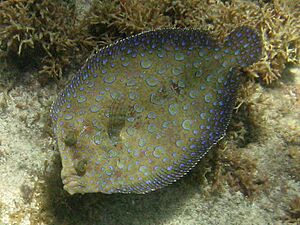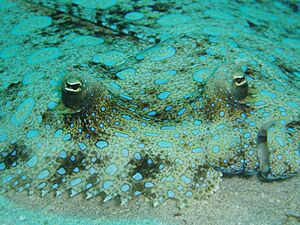Plate fish facts for kids
Quick facts for kids Plate fish |
|
|---|---|
 |
|
| Conservation status | |
| Scientific classification | |
| Synonyms | |
|
The plate fish (Bothus lunatus) is a type of flounder. It lives in the warmer parts of the Atlantic Ocean, including the Caribbean Sea. This fish usually lives on sandy areas near coral reefs. It is very good at changing its colors to blend in with its surroundings. This helps it hide from other animals. Sometimes, people call it the peacock flounder. Another similar fish, Bothus mancus, also shares this name.
Contents
Meet the Plate Fish: What it Looks Like
The plate fish has a flat body, like a pancake! It lies on the seabed with its right side down. Its left side faces upwards. Both of its eyes are on this top side. They can even stick out a little on short stalks.
The fish has a round shape. Its top fin (dorsal fin) and bottom fin (anal fin) almost go all the way around its body. It also has long side fins (pectoral fins) that often stand up.
An average plate fish grows to about 35 centimeters (14 inches) long. The biggest ones can reach up to 46 centimeters (18 inches). The top of the fish can be grey, brown, or tan. It has small blue spots and blue circles. Its head and fins also have blue spots. There are usually two or three faint dark spots along its side.
Amazing Camouflage: How Plate Fish Change Color
One of the coolest things about the plate fish is its ability to change color. It can match its skin to the sand or rocks around it. This helps it hide perfectly on the seabed. Fish in this group can change their color very quickly. They can do it in just two to eight seconds! This amazing skill helps them stay safe from predators.
Where Plate Fish Live: Habitat and Range
The plate fish lives in warm, tropical waters. You can find it in parts of the Atlantic Ocean and the Caribbean Sea. Its home stretches from Florida, the Bahamas, and Bermuda all the way to Brazil. However, it does not live in the Gulf of Mexico. You can also find it near the Gulf of Guinea and Ascension Island.
This fish usually lives in water that is 1 to 20 meters (3 to 66 feet) deep. But sometimes, it can be found as deep as 100 meters (330 feet). Its favorite places are sandy areas near coral reefs. It also likes seagrass meadows or areas near mangrove trees. Sometimes, you might see it over rocky or hard surfaces. It is one of the most common flounders found near coral reefs.
How Plate Fish Behave: Hunting and Hiding
The plate fish is very good at hiding. It often lies on the sandy seabed, sometimes even burying itself a little in the sand. When it swims, it does so in short bursts. It stays very close to the bottom, following the ripples in the sand.
In the Caribbean, a small octopus called Macrotritopus defilippi copies the way the plate fish swims. This copying behavior might help the octopus stay safe. Predators that might eat a soft octopus might not want to attack a flat, rigid fish.
What Plate Fish Eat: An Ambush Predator
The plate fish is a skilled hunter. In the West Indies, it mostly eats other fish. About 85% of its diet is made up of fish. It especially likes small herrings and the bigeye scad. It also eats mantis shrimps and octopuses.
The plate fish is an ambush predator. This means it hides and waits for its prey. It lies perfectly still and hidden on the seabed. When an unsuspecting fish or shrimp swims too close, the plate fish quickly darts out to catch it!



